- Print
- DarkLight
- PDF
Styling Your Map
- Print
- DarkLight
- PDF
Visual map analysis is an art that can easily be mastered in LightBox Vision. The map styling tools enable you to visually distinguish the important attributes of your data. The value of your data increases as trends and insights become visible on the map. Learn how to style your data/layers in LightBox Vision to get the most of your workflow objectives.
Classifying Data Overview
Once you import a data set into LightBox Vision™, you can work with it as a layer. You can style the visual attributes for a layer (i.e.; fill color, opacity, image type, image color, image size, etc.) in two primary ways: unclassified and classified
- Unclassified Data: When you first view your data in LightBox Vision™ it is unclassified. Unclassified data means the style doesn't vary at all even though the field values do vary. In the example below, the Zoning layer is unclassified, meaning all the polygons are given the same red color.

- Classified Data: Classifying your data allows you to define a variety of styles for your fields, depending on the values contained in that field. For example, if you have a City Zoning layer, you can classify that layer and have the fill color tied to Land Use code. This allows you to quickly identify patterns in the data, and determine which area falls within a specific zone or land use.
Styling Data Overview
The Style Editor enables you to style the visual attributes of unclassified data and the Ramp Editor enables you to classify your data and define style rules. To style the visual attributes of unclassified data, use the drop-down menus on the left side of the Style Editor. In the example below a red fill color is being changed to blue from the Fill Color menu.
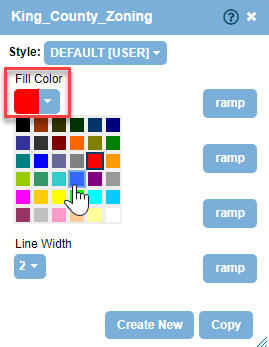
To open the Ramp Editor so that you can classify an attribute of your data such as Fill Color, click the Ramp button to the right of the attribute. From here you can choose the Field of data to color-code off of as well as a variety of ramp color options.
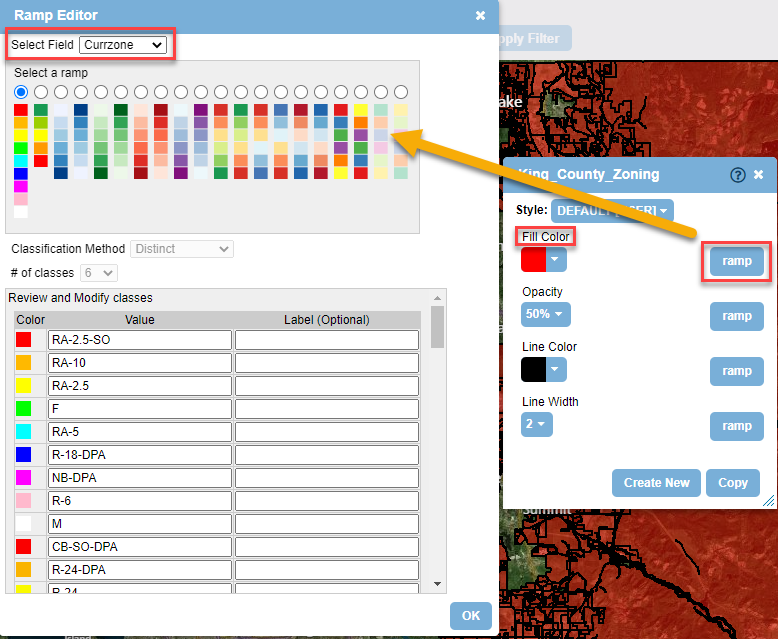
To open the Style Editor, see Creating a New Style below. The Style Editor includes these features:
- Style drop-down menu: Select a style to tie to your layer (data set) and/or edit. The menu lists all available styles for your layer. All layers are created with a style named Default which is automatically saved in the User folder. The first time you work with a layer, the only style available in the drop-down menu is Default [USER].
- Create New: Create a new style.
- Copy: Copy the style displayed in the Style drop-down menu, and create as a new style.

Styling Polygon Layers
1. Select the Options icon to the right of your polygon layer name in the Layers Menu.
2. Select Edit Style and the Style Editor opens.

There are four options for a polygon layer: Fill Color, Opacity, Line Color, and Line Width. The sections below explain how to style these visual attributes for polygon layers in two primary ways: unclassified and classified (see Classifying Data Overview above for more information.)
Styling Unclassified Polygon Layers
To change the visual attributes of unclassified data, use the drop-down menus on the left side of the Style Editor.
- Fill Color: Click the down arrow to open the fill color menu. Select the fill color by clicking on a color swatch. Your selected fill color appears in the Style Editor and becomes the fill color of your polygon layer.
- Opacity: Select the opacity of the fill color from the drop-down menu. The range of opacity is 0% (no fill color visible) to 100% (solid fill color). A fill color with 0% opacity is not visible on the map. Your selected opacity percent appears in the Style Editor and is applied to the fill color of your polygon layer.
- Line Color: Click the down arrow to open the line color menu. Select the line color by clicking on a color swatch. Your selected line color appears in the Style Editor and the lines of your polygon layer.
- Line Width: Select the line width from the drop-down menu. Your selected line width appears in the Style Editor and is applied to the lines of your polygon layer.
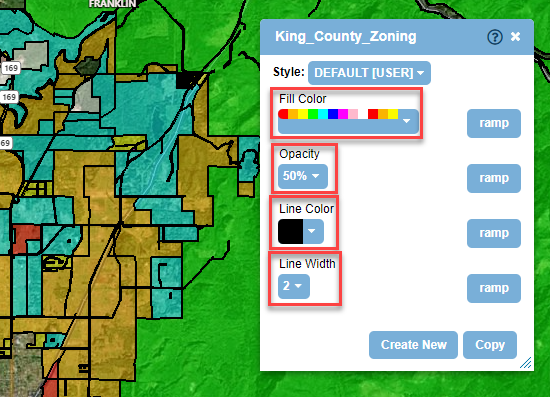
Styling Classified Polygon Layers
Classifying on Fill Color:
1. Click the Ramp button for Fill Color. The Ramp Editor opens.
2. Select the field you want to tie the style variation to from the Select Field drop-down menu.
3. Click the radio button above a color ramp to select it.
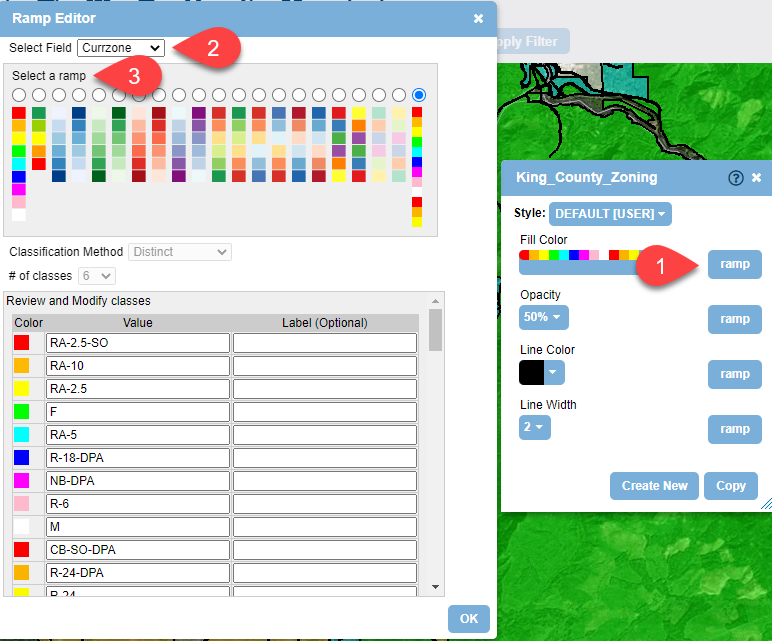
Stepped & Smooth Ramps Overview
The type of ramp that you choose is an important part of the visual classification scheme of your data and the effectiveness of your analysis. It determines the classification methods that you can select.
Stepped Ramps:
- These are composed of individual color swatches. Each color swatch has a different value.
- In the Ramp Editor you must select a Classification Method and # of Classes for stepped ramps.
- There are four types of classification methods. Each method classifies data in a different way. Selecting the best method for your data set optimizes your data classification.
- The # of Classes you select determines the range of values represented by the individual color swatches of a stepped ramp. It is the best practice to select 5 to 7 classes for a stepped ramp. (See Tips on Classifying Data further below for more information.)
Smooth Ramps:
- The colors in smooth ramps are blended together.
- Select a smooth ramp if you'd like to visually differentiate a wide range of values on the map. In the Ramp Editor, the Classification Method and # of Classes are grayed out. They do not apply to smooth ramps.
- The Review and Modify Classes table automatically populates with three color swatches and the minimum, median, and maximum field values for your selected smooth ramp. You can make modifications in the table if desired, such as changing a color.
Classification Method and # of Classes
These options can be found after choosing the Ramp option when you Edit Style on a layer
- Classification Method: Select Natural Breaks, Distinct, Quantile, or Equal Interval from the drop-down menu
- # of Classes: Select the number of classes from the drop-down menu LightBox Vision Thematic Mapper Number Classes.
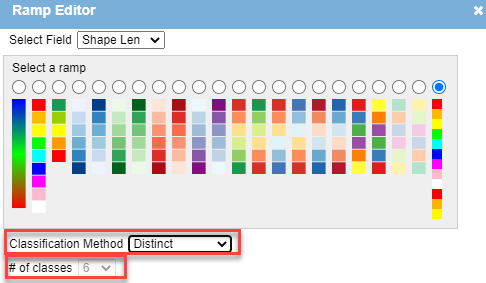
Review and Modify Classes Table
The Review and Modify Classes table enables you to try out different classification schemes before applying one:
- Based on your choice of Classification Method and # of classes, the Review and Modify Classes table populates with the fill color, value, and label for your selected data field.
- To further modify your classification scheme, you can make these selections in the table:
- Color: Click on any ramp color to change it. The Color Selector opens (See Tips for Using the Color Selector below).
- Value: Click a value to enter a new left end-point in the Edit Value window.
- Label (Optional): Type a label for any data value. The Legend displays your label instead of the value.
To apply your classification scheme, click the OK button at the bottom of the Ramp Editor. The Fill Color button in the Style Editor displays your selected ramp.
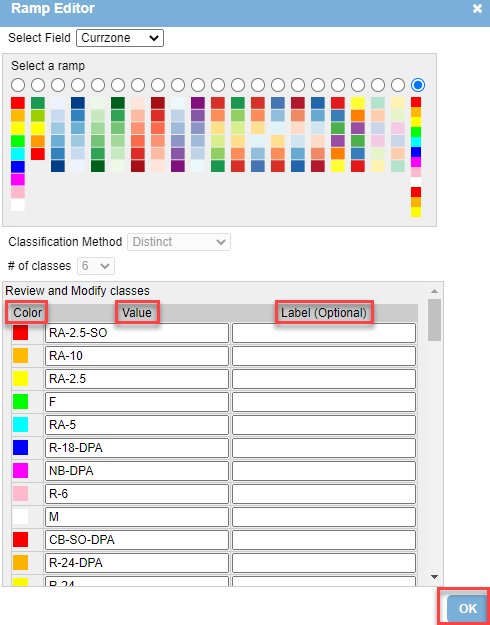
Classifying on Opacity
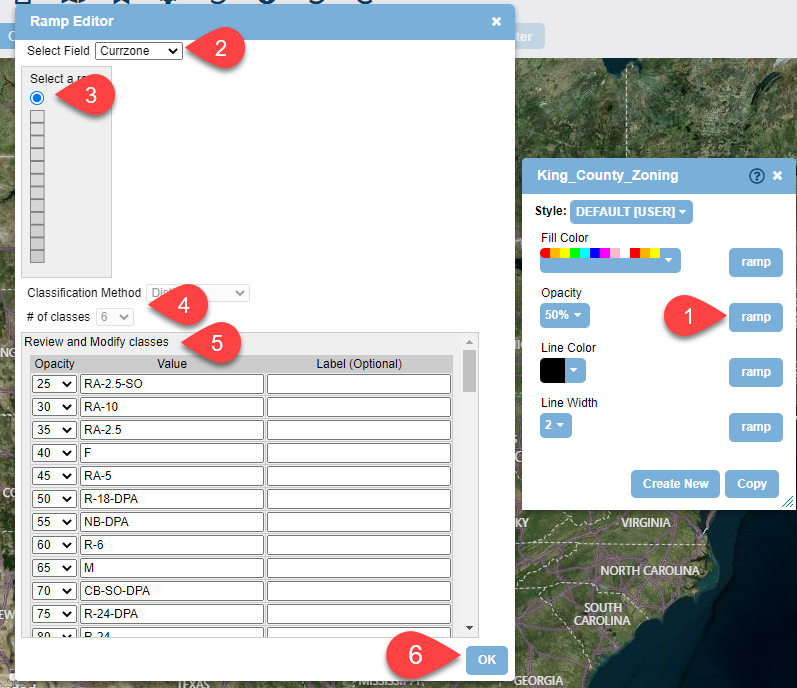
1. After choosing Edit Style next to your layer on your Layers Menu, select the Ramp button for Opacity. The Ramp Editor opens.
2. Select a field you want to tie the style variation to from the Select Field drop-down menu.
3. Click the radio button above an opacity ramp to select it.
4. Select a Classification Method and # of Classes. Based on your choices, the Review and Modify Classes table populates with the opacity, value, and label for your classified data field (see Tips on Classifying Data below for definitions and tips)
5. In the Review and Modify Classes table you can change the opacity assigned to your classes. Click a value to edit the left end-point or type a label for any data value. (The Legend displays your label instead of the value.)
6. To apply your classification scheme, click the OK button at the bottom of the Ramp Editor. The Opacity button in the Style Editor displays your selected ramp.
Classifying on Line Color
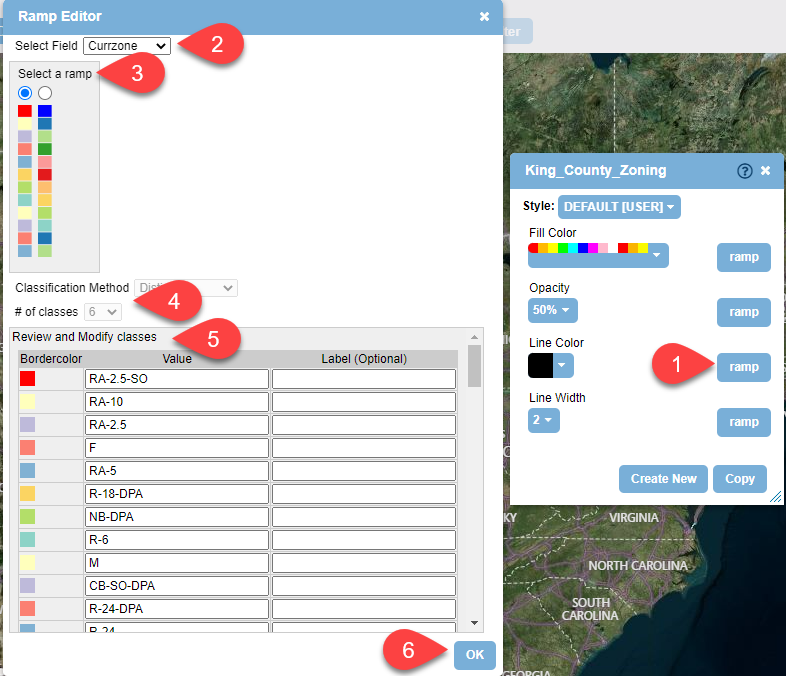
1. Click the Ramp button after choosing to Edit Style on your Layer of choice. The Ramp Editor opens.
2. Select a Field you want to tie the style variation to from the Select Field drop-down menu
3. Click the radio button above a line color ramp to select it.
4. Select a Classification Method and # of Classes. Based on your choices, the Review and Modify Classes table populates with the bordercolor, value, and label for your classified data field (see Tips on Classifying Data below for definitions and tips).
5. In the Review and Modify Classes table, you can click on any border color to change it. Click a value to edit the left end-point or type a label for any data value. (The Legend displays your label instead of the value.)
6. To apply your classification scheme, click the OK button at the bottom of the Ramp Editor. Each polygon on the map is assigned a border color from your selected ramp. The Line Color button in the Style Editor displays the ramp.
Classifying on Line Width

1. Click the Ramp button after choosing to Edit Style on your Layer. The Ramp Editor opens.
2. Select a field you want to tie the style variation to from the Select Field drop-down menu.
3. Click the radio button above a line width ramp to select it.
4. Select a Classification Method and # of Classes. Based on your choices, the Review and Modify Classes table populates with the size, value, and label for your classified data field. (See Tips on Classifying Data below for definitions and tips.)
5. In the Review and Modify Classes table you can change the size of the line width assigned to your classes, click a value to edit it, or type a label for any data value. (The Legend displays your label instead of the value.)
6. To apply your classification scheme, click the OK button at the bottom of the Ramp Editor. The Line Width button in the Style Editor displays your selected ramp.
Styling Point Layers
1. Click the Options icon to the right of your point layer name in the Layers Menu.
2. Click Edit Style in the menu. The Style Editor opens.
- There are four options for a point layer: Image, Color, Opacity, and Size. The sections below explain how to style these visual attributes for point layers in two primary ways: unclassified and classified. (See Classifying Data Overview above for more information.)
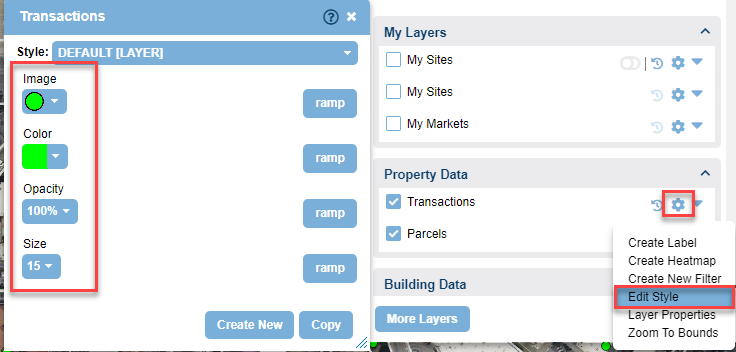
Styling Unclassified Point Layers
To change the visual attributes of unclassified data, use the drop-down menus on the left side of the Style Editor.
- Image: Select an image from the drop-down menu. Your selected image appears in the Style Editor, and becomes the image for all the points in your point layer.
- Color: Click on a color swatch in the drop-down color menu. Your selected color appears in the Style Editor, and becomes the color for all the images in your point layer.
- Opacity: Select the opacity of the image color from the drop-down menu. The range of opacity is 0% (no fill color visible) to 100% (solid fill color). A color with 0% opacity is not visible on the map. Your selected opacity percent appears in the Style Editor, and is applied to the color of all the images in your point layer.
- Size: Select the image size from the drop-down menu. Your selected size appears in the Style Editor, and is applied to all the images in your point layer.
Styling Classified Point Layers
Classifying on Image
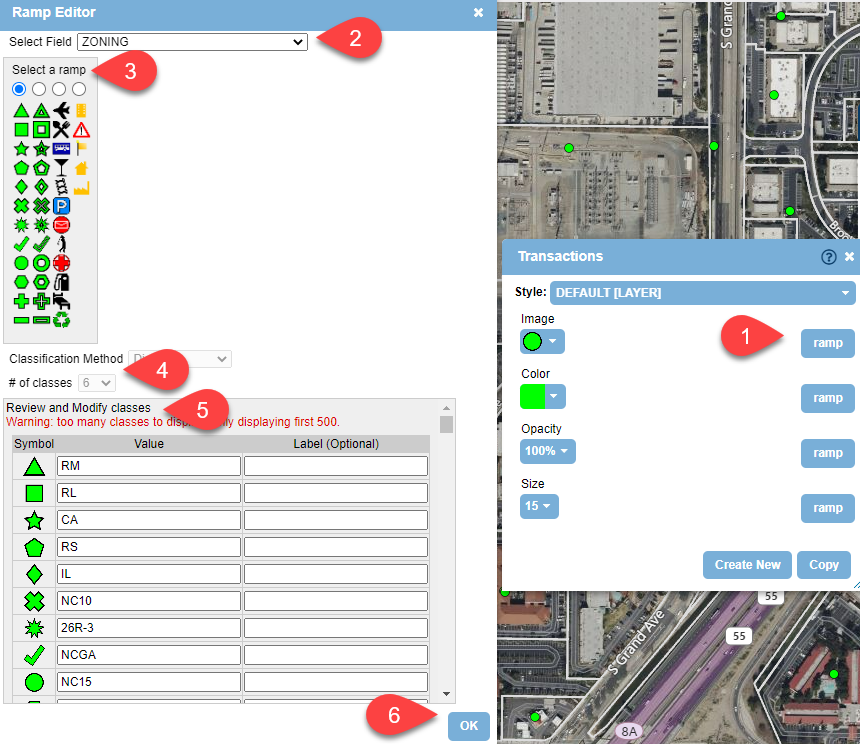
1. Click the Ramp button. The Ramp Editor opens.
2. Select a Field you want to tie the style variation to from the Select Field drop-down menu
3. Click the radio button above an image ramp to select it.
4. Select a Classification Method and # of Classes. Based on your choices, the Review and Modify Classes table populates with the symbol, value and label for your classified data field. (See Tips on Classifying Data below for definitions and tips).
5. In the Review and Modify Classes table, you can click on any symbol to change it, click a value to edit it, or type a label for any data value (the Legend displays your label instead of the value)
6. To apply your classification scheme click the OK button at the bottom of the Ramp Editor. The Image button in the Style Editor displays your selected ramp.
Classifying on Color
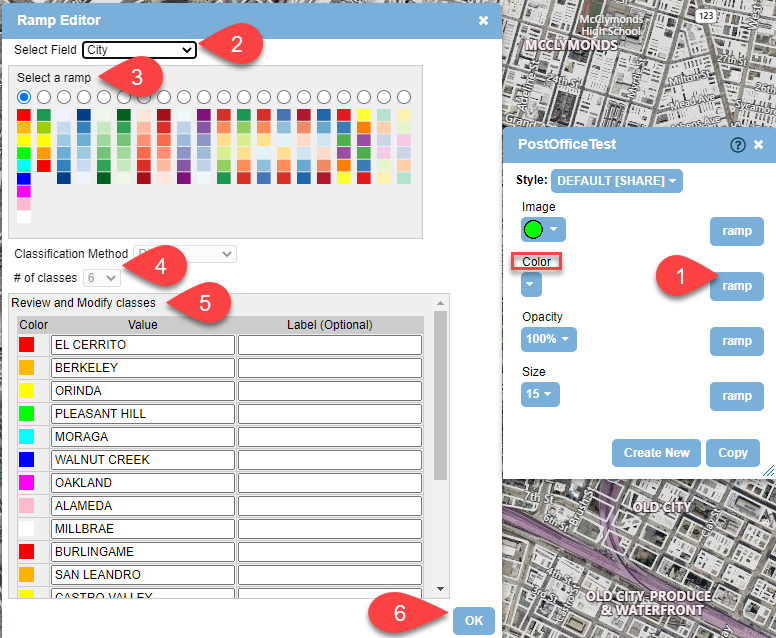
1. Click the Ramp button after choosing to Edit Style on your point Layer. The Ramp Editor opens.
2. Select a Field you want to tie the style variation to from the Select Field drop-down menu.
3. Click the radio button above a point color ramp to select it.
4. Select a Classification Method and # of Classes. Based on your choices, the Review and Modify Classes table populates with the color, value, and label for your classified data field. (See Tips on Classifying Data below for definitions and tips).
5. In the Review and Modify Classes table you can click on any color to change it, click a value to edit it, or type a label for any data value (the Legend displays your label instead of the value).
6. To apply your classification scheme, click the OK button at the bottom of the Ramp Editor. The Color button in the Style Editor displays your selected ramp.
Classifying on Opacity

1. Click the Ramp button. The Ramp Editor opens.
2. Select a field you want to tie the style variation to from the Select Field drop-down menu.
3. Click the radio button above an opacity ramp to select it.
4. Select a Classification Method and # of Classes. Based on your choices, the Review and Modify Classes table populates with the opacity, value, and label for your classified data field. (See Tips on Classifying Data below for definitions and tips.)
5. In the Review and Modify Classes table you can change the opacity assigned to your classes, click a value to edit the left end-point, or type a label for any data value (the Legend displays your label instead of the value).
6. To apply your classification scheme, click the OK button at the bottom of the Ramp Editor. The Opacity button in the Style Editor displays your selected ramp.
Classifying on Size
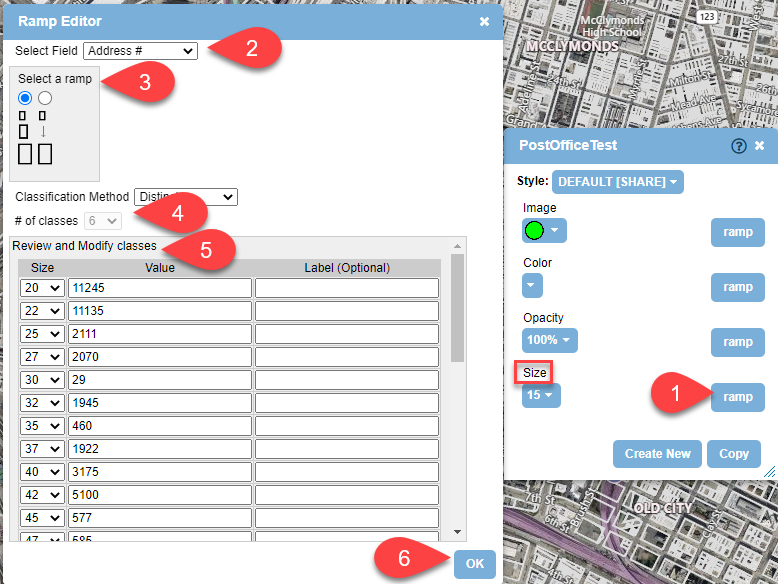
1. Click the Ramp button. The Ramp Editor opens.
2. Select a Field you want to tie the style variation to from the Select Field drop-down menu.
3. Click the radio button above a ramp to select it.
4. Select a Classification Method and # of Classes. Based on your choices, the Review and Modify Classes table populates with the size, value, and label for your classified data field (see Tips on Classifying Data below for definitions and tips).
5. In the Review and Modify Classes table you can change the size of the symbol assigned to your classes, click a value to edit it, or type a label for any data value (the Legend displays your label instead of the value).
6. To apply your classification scheme, click the OK button at the bottom of the Ramp Editor. The Size button in the Style Editor displays your selected ramp.
Styling Line Layers
1. Click the Options icon to the right of your line layer name in the Layers Menu.
2. Click Edit Style in the menu. The Style Editor opens.
3. There are two options for a line layer: Line Color and Line Width. The sections below explain how to style these visual attributes for line layers in two primary ways: unclassified and classified. (See Classifying Data Overview above for more information.)
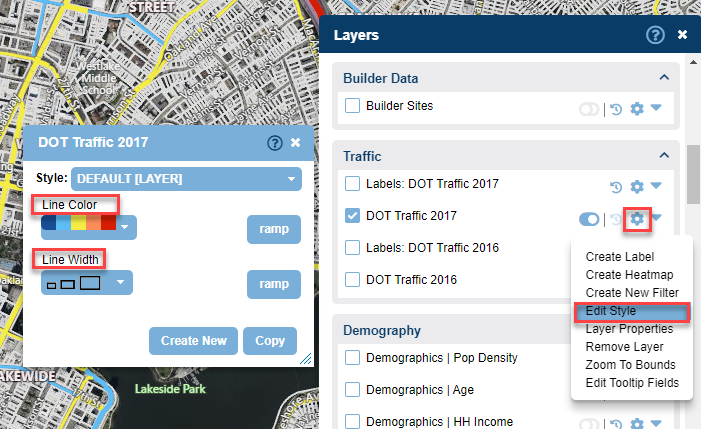
Styling Unclassified Line Layers
To change the visual attributes of unclassified data, use the drop-down menus on the left side of the Style Editor next to your line layer (see above image for reference).
- Line Color: Click the down arrow to open the line color menu. Select the line color by clicking on a color swatch. Your selected line color appears in the Style Editor for the lines of your line layer.
- Line Width: Select the line width from the drop-down menu. Your selected line width appears in the Style Editor and is applied to the lines of your line layer.

Styling Classified Line Layers
Classifying on Line Color
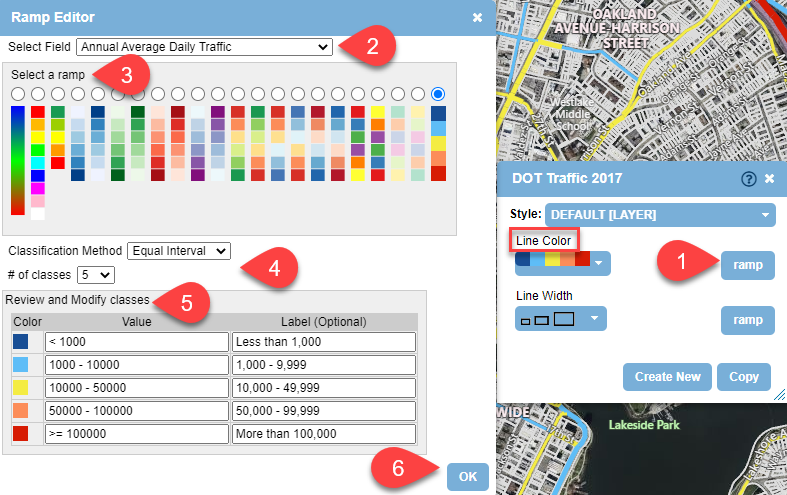
1. Click the Ramp button for Line Color. The Ramp Editor opens.
2. Select a Field you want to tie the style variation to from the Select Field drop-down menu.
3. Click the radio button above a line color ramp to select it.
4. Select a Classification Method and # of Classes. Based on your choices, the Review and Modify Classes table populates with the color, value, and label for your classified data field (see Tips on Classifying Data below for definitions and tips)
5. In the Review and Modify Classes table you can click on any color to change it, click a value to edit it, or type a label for any data value (the Legend displays your label instead of the value)
6. To apply your classification scheme click the OK button at the bottom of the Ramp Editor. The Line Color button in the Style Editor displays your selected ramp.
Classifying on Line Width

1. Click the Ramp button. The Ramp Editor opens.
2. Select a Field you want to tie the style variation to from the Select Field drop-down menu
3. Click the radio button above a line width ramp to select it.
4. Select a Classification Method and # of Classes. Based on your choices, the Review and Modify Classes table populates with the size, value, and label for your classified data field (see Tips on Classifying Data below for definitions and tips).
5. In the Review and Modify Classes table you can change the size of the line width assigned to your classes, click a value to edit it, or type a label for any data value (the Legend displays your label instead of the value)
6. To apply your classification scheme, click the OK button at the bottom of the Ramp Editor. The Line Width button in the Style Editor displays your selected ramp.
Tips on Classifying Data
This section provides definitions and tips to help you optimize your data classification. The Classification Method and # of classes that you chose for your data can affect the outcome of your analysis.
Classification Method
There are four types of classification methods:
Natural Breaks
- Divides data into classes based on natural breaks in the data distribution
- Calculates groupings of data values based on data distribution and seeks to reduce variance within groups and maximize variance between groups
- Limitation: Class ranges are specific to the data set so it is difficult to compare a map with another map and to choose the optimum # of classes especially if the data is evenly distributed
Distinct
- The only classification method for fields containing text
- Creates a separate class for each unique value in the data set
- Limitation: if you have a large number of unique values in your data set, your thematic map will be difficult to interpret due to too many different symbols/colors
Quantile
- Divides a data set that divide into "n" groups, containing (to the extent possible) equal numbers of observations
- Desirable in that this method produces distinct map patterns and minimizes the impact of skewed data
- Highlights changes in the middle distribution values because the intervals are generally wider at the extremes
- Limitation: areas with similar values can end up in different classes while areas with very different values can end up in the same class
Equal Interval
- Simplest method for classifying data
- Divides a set of data values into groups each of which represents the same range of values
- Better communicates trends with continuous sets of data. Works well with familiar data ranges such as percentages or temperature.
- Limitation: not good for non-normally distributed data sets because you might get a map with many features in 1 or 2 classes and some classes with no features
# of Classes
It is the best practice to select 5 to 7 classes for a step ramp. If you select too many classes for a step ramp, it may be difficult to gain insight from the color style on the map. If you would like to visually differentiate a wide range of values, use a smooth color ramp.
Adding Layers to the Menu
The Browse Layers window enables you to load your data into LightBox Vision™ and add your new layers to the Layers Menu. Once in the menu, you can use Map Styler to format and display your new layers.
Add your new layers to the Menu:
1. After you load one or more data sets (see documentation on loading), click on your new layer(s) in the Available list in the Browse Layers window. The example image further below displays two selected layers. To select more than one layer while holding down the Ctrl key on your keyboard, click on each layer you'd like to select.
2. Click the right arrow icon to move your selected layers to the Active list.
3. Click the OK button. LightBox Vision™ adds your new layers to the list of all active layers in the menu (you may have to scroll down the menu to see your new layers).
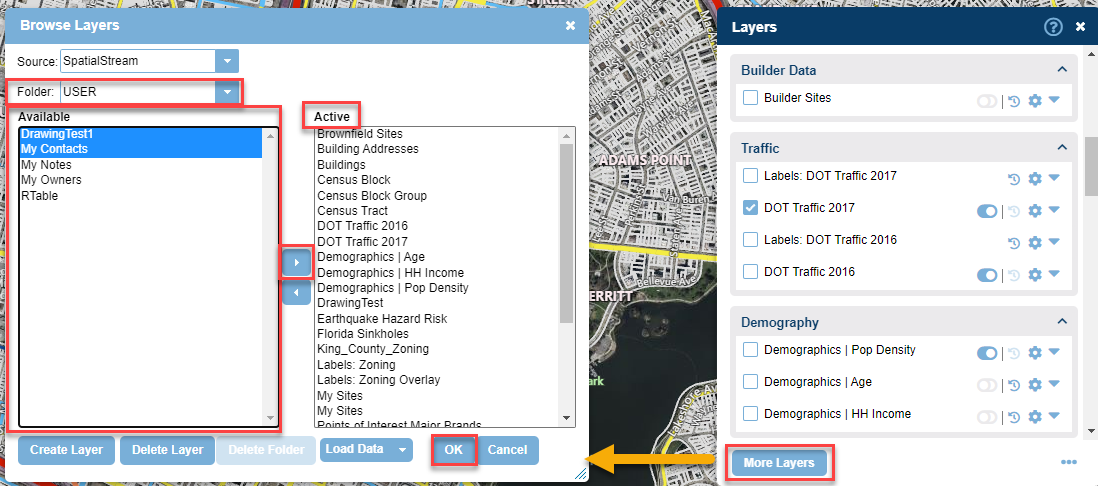
Creating a New Style
Most layers will allow for its style to be edited however the exception to this is integrated Esri layers. To learn more about the Esri add-on and its specifications, see the documentation here.
Follow the steps below for styling non-Esri layers:
1. Click the Options icon to the right of your layer name in the menu.
2. Click Edit Style in the menu. The Style Editor opens.
3. Click the Create New button at the bottom of the Style Editor.
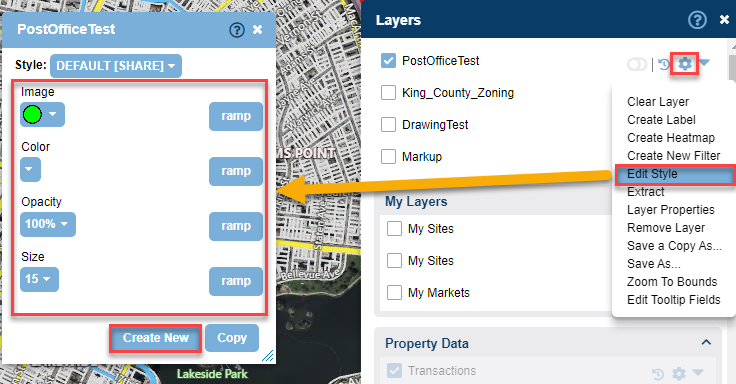
4. Enter a name for your style in the Create Style window. The style name does not support special characters. It supports upper and lower case letters, spaces and underscores.
5. Leave default Style as Thematic.
6. Click the OK button. Your new style name appears in the Style drop-down menu. You can now format the visual attributes of your new style.
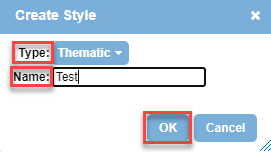
Copying a Style
1. Click the Options icon to the right of your layer name in the menu.
2. Click Edit Style. The Style Editor opens.
3. Click the Copy button at the bottom of the Style Editor. The Copy To... window opens.
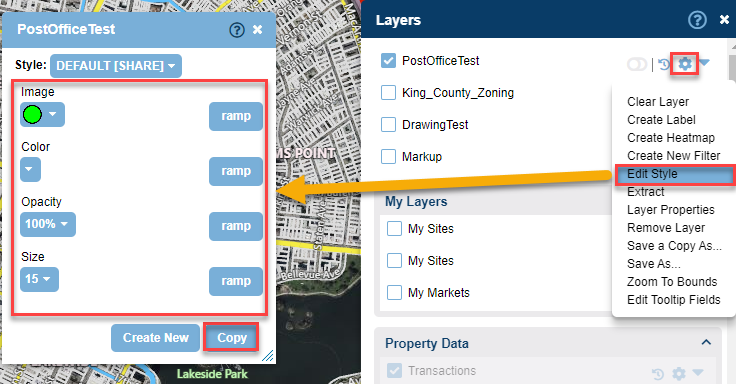
4. Select the Folder to save the copy of the style.
5. Enter a new Name for the style. You must change the name of the original style to copy to the folder it is saved in. The style name does not support special characters. It supports upper and lower case letters, spaces and underscores.
6. Click the OK button. The copy of the style appears in the Style drop-down menu. You can now format the visual attributes of the style if desired.
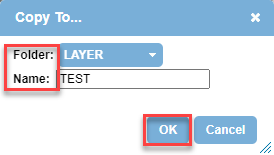
Creating a Label Layer
Most layers can have a label layer made off of them but there is an exception when it comes to Esri layers as those layers will not offer the option of label creation. To learn more about the Esri add-on and it's specifications, see the documentation here.
Please see the steps below on creating a label layer on a non-Esri layer:
1. Click the Options icon to the right of your layer name in the Legend.
2. Click Create Label in the menu.
3. Select a Field from the drop-down menu that contains the values you would like to appear on the label(s). In the example image below, the values of the APN field are the parcel numbers.
4. Click the OK button. The map displays the label(s), and the menu displays the label layer.
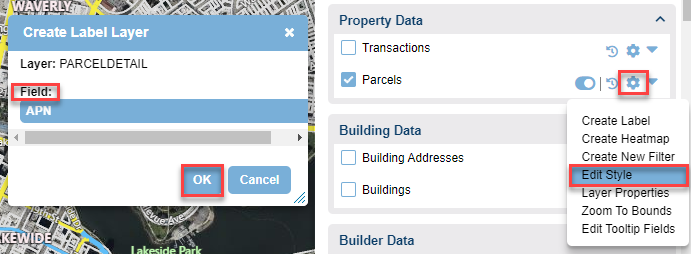
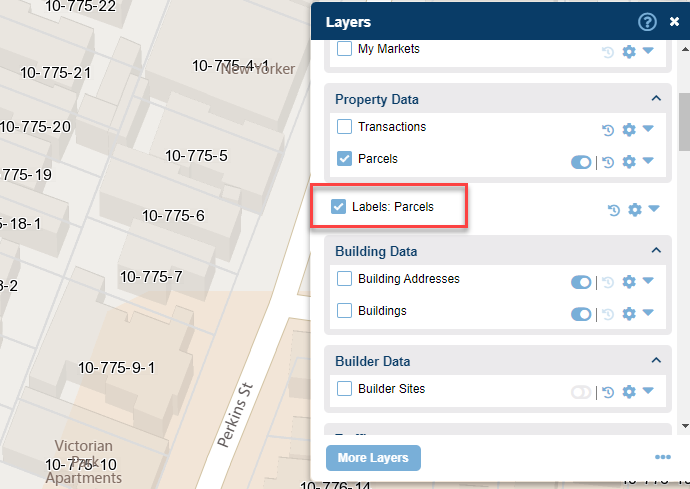
Tips for Using the Color Selector
The Color Selector works the same for both Fill Color and Line Color, except that the opacity setting does not apply to Line Color. Each color has Red, Green, and Blue (RGB) values. The values range from 0 to 255. Fill Color has an Alpha value for opacity. Opacity value ranges from 0.0 (clear) to 1.0 (solid color). A color with 0.0 opacity is not visible on the map.
- To pick a color using the Color Wheel, click on the wheel. To change the shade of the color, move your mouse in the box inside the wheel.
- To select the opacity for Fill Color only, move the slider.

.png)

.png)